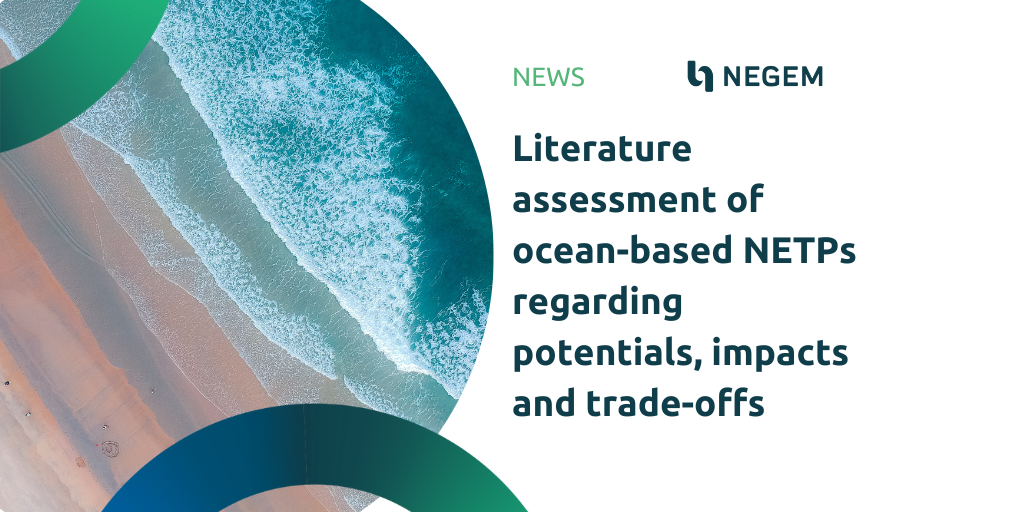Marine NETPs have significant potential to both capture and store CO2 directly or indirectly from the atmosphere, but their environmental impacts need to be further investigated and weighted to thoroughly assess their risks and benefits.
While the deployment of natural and engineered marine NETPs could remove and store vast amounts of CO2 annually, there are still many gaps in the scientific literature around these solutions as only a handful of experiments have been carried out so far and none has been proven to work at a large scale.
Even though marine NETPs can help mitigate climate change, it is expected that they will have some negative effects on marine ecosystems and on seawater chemistry. More studies are needed to weigh the climate mitigation effects of marine NETPs against their potential negative environmental impacts.
In its process of evaluating the feasibility of different carbon dioxide removal (CDR) solutions, the NEGEM Project released a literature review on the climate benefits and environmental impacts of marine negative emission technologies and practices (NETPs).
The deliverable takes into consideration three NETPs:
- Blue Carbon, i.e., extension, conservation, or restoration of ecosystems like mangroves, seagrass meadows, seaweed forests or algae populations to remove CO2 from the atmosphere via photosynthesis and store it on the seafloor (or under it) as organic sediments when the biomass dies, thus locking it away from re-entering the atmosphere.
- Ocean liming, also known as ocean alkalinity enhancement (OAE) or artificial ocean alkalization (AOA). This solution consists of adding mineral substances to the sea water to increase its alkalinity, thus increasing its capacity to absorb CO2 and turn it into bicarbonate and carbonate ions via chemical transformation. Another method is coastal enhanced weathering, where the minerals are added on beaches, where they promote the CO2 absorbing reactions of silicate minerals.
- Sub-sea geological storage of CO2, where CO2 captured from the air or from emission points is transported and stored beneath the deep-sea floor so it can react with underground geological formation and turn into solid compounds.

As there is no existing experience of industrial-scale CDR solution in the ocean, the current understanding of the issue come from common scientific knowledge of geo-biochemical and physical processes in seawater, plus the results from some small experiments and numerical modelling derived from hydrodynamic and biogeochemical models.
All three of the solutions considered present both climate change mitigation potential and potential harmful environmental impacts:
- If just the established blue carbon solutions were fully implemented (so excluding large scale seaweed farming and other nascent solutions), they would abate between 1% and 3% of current annual emissions. Including seaweed farming would increase this figure to around 7%, and including other nascent solution would bring it to about 10%. Despite this, the extension of these ecosystems and populations of seaweed could disturb pre-existing ecosystems, as well as deprive the water of the necessary oxygen and nutrients to sustain other forms of life.
- It has been calculated that increasing the CO2 sequestration capacity of the global surface ocean by 1% via ocean liming would lessen the atmospheric CO2 load by 11%. Despite this great potential, there are many risks involved in the process of enhancing the alkalinity of the oceans. For example, some species who are not able to tolerate higher water alkalinity might be endangered, and the chemical reactions of a more alkaline seawater could increase the accumulation of contaminants like cadmium, nickel and chromium in food chains. Furthermore, large scale ocean liming would require intense levels of mining to extract the minerals required, as well as transportation to the deployment sites, thus triggering significant environmental impacts.
- Even though geological storage of CO2 beneath the seafloor is already ongoing in a few sites and no such incidents have been reported so far, there is a risk of CO2 leaking during the transportation process or through fractures in the underground formations where it is stored and re-entering the ocean and the atmosphere.
Further research is thus needed to accurately evaluate the risk/benefit profile of each marine NETP and its actual feasibility and sustainability as a large scale CDR solution.


